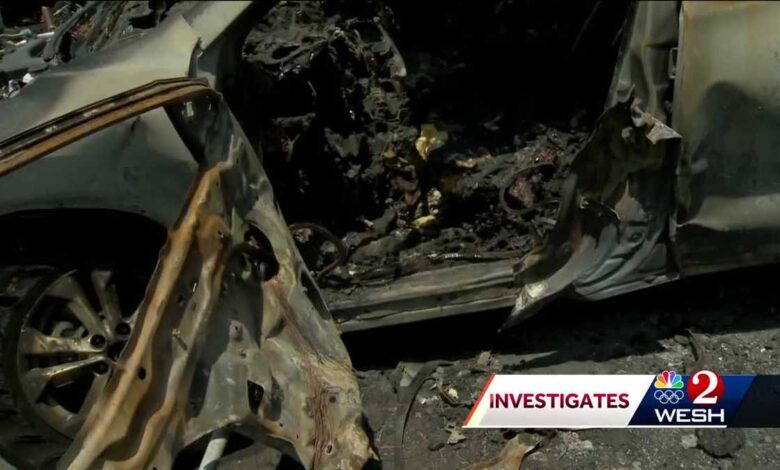Florida eying lithium battery safety policies with rise in electric vehicles

Andrew Sullivan with St. Cloud Fire Rescue showed WESH 2 News the remains of a Mercedes Benz electric vehicle, or EV, that suddenly erupted in flames in a tow yard Wednesday. It scorched half a dozen other vehicles before firefighters could drag it away and try to extinguish the fire. But it’s an electric vehicle, and posed a major problem.“With these chemical fires like these lithium ion batteries sometimes it’s very, extraordinarily difficult to extinguish,” Sullivan said. “The heat just comes back. They can reignite, and sometimes explosively so.” Firefighters often struggle to get enough water on burning EV vehicle batteries because they’re underneath, often encased in metal. That makes it difficult to get water under and up into the battery compartment. Throughout Florida, with more than 400 fire and rescue departments, there are no standard procedures for fighting electric vehicle fires. That reality was amplified when 20 electric vehicles, flooded during Hurricane Ian in September 2022, later began burning. Chief Financial Officer and State Fire Marshal Jimmy Patronis said, “The danger is known! It’s is real. And now is the time to act.” He was speaking in Orlando this week and announced the start of rule-making hearings with the makers of lithium ion batteries for cars, phones, golf carts and some children’s toys, automakers and firefighters, to create statewide best practices for storing lithium ion batteries, and responding to fires.“So we have a collaborative effort to push forward the policies in order to keep our first responders and our citizens safe,” he said. Since firefighter health is threatened by the toxins emitted from burning lithium ion batteries, Patronis pointed out a new Florida law {HB 989} that ensures firefighters receive money and benefits when contracting certain cancers.“Their leave time for treatment and recovery is a benefit provided upon diagnosis,” said Wayne “Bernie” Bernoska, president of Florida Professional Firefighters representing 28,000 firefighters and paramedics throughout state. “Firefighters shouldn’t lose their jobs just because they are diagnosed with cancer.” While concerns over battery fires is increasing, so is the market, with 26 million electric vehicles projected to be on the roads by 2030.Just last month, the National Highway Traffic Safety Administration began the process of making new rules for manufacturers.They would require changes to battery compartments to prevent fires, and require automakers to provide standardized emergency response information for first responders fighting fires.
Andrew Sullivan with St. Cloud Fire Rescue showed WESH 2 News the remains of a Mercedes Benz electric vehicle, or EV, that suddenly erupted in flames in a tow yard Wednesday.
It scorched half a dozen other vehicles before firefighters could drag it away and try to extinguish the fire. But it’s an electric vehicle, and posed a major problem.
“With these chemical fires like these lithium ion batteries sometimes it’s very, extraordinarily difficult to extinguish,” Sullivan said. “The heat just comes back. They can reignite, and sometimes explosively so.”
Firefighters often struggle to get enough water on burning EV vehicle batteries because they’re underneath, often encased in metal. That makes it difficult to get water under and up into the battery compartment.
Throughout Florida, with more than 400 fire and rescue departments, there are no standard procedures for fighting electric vehicle fires.
That reality was amplified when 20 electric vehicles, flooded during Hurricane Ian in September 2022, later began burning.
Chief Financial Officer and State Fire Marshal Jimmy Patronis said, “The danger is known! It’s is real. And now is the time to act.”
He was speaking in Orlando this week and announced the start of rule-making hearings with the makers of lithium ion batteries for cars, phones, golf carts and some children’s toys, automakers and firefighters, to create statewide best practices for storing lithium ion batteries, and responding to fires.
“So we have a collaborative effort to push forward the policies in order to keep our first responders and our citizens safe,” he said.
Since firefighter health is threatened by the toxins emitted from burning lithium ion batteries, Patronis pointed out a new Florida law {HB 989} that ensures firefighters receive money and benefits when contracting certain cancers.
“Their leave time for treatment and recovery is a benefit provided upon diagnosis,” said
Wayne “Bernie” Bernoska, president of Florida Professional Firefighters representing 28,000 firefighters and paramedics throughout state. “Firefighters shouldn’t lose their jobs just because they are diagnosed with cancer.”
While concerns over battery fires is increasing, so is the market, with 26 million electric vehicles projected to be on the roads by 2030.
Just last month, the National Highway Traffic Safety Administration began the process of making new rules for manufacturers.
They would require changes to battery compartments to prevent fires, and require automakers to provide standardized emergency response information for first responders fighting fires.



